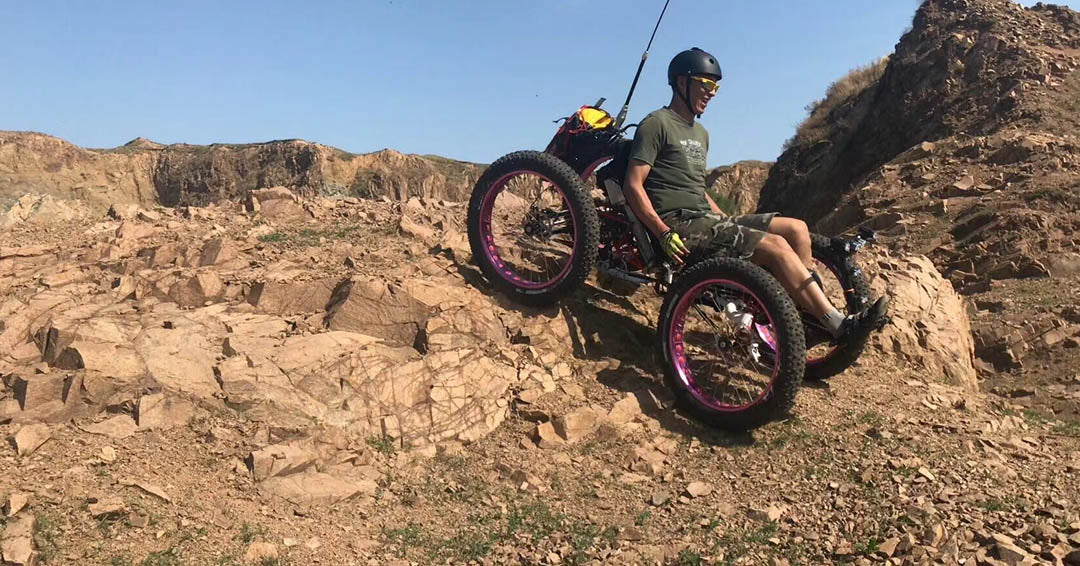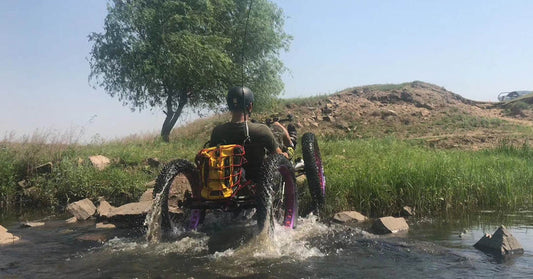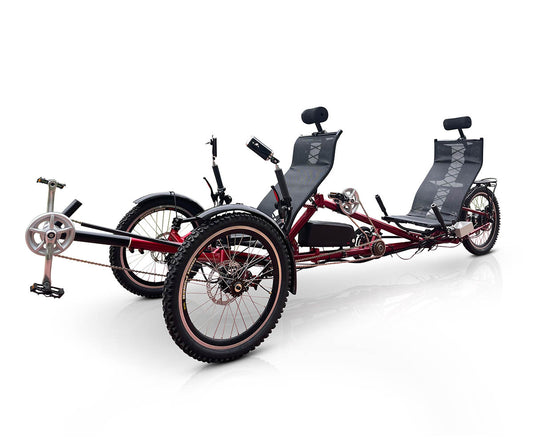
Unlocking Possibilities: A Comprehensive Guide to Adaptive Bike Features
Share
The world of cycling is as diverse as its riders, each bringing their unique journey to the trails, roads, and paths that weave through our lives. Among the myriad of options available to cyclists, recumbent adaptive bikes and quads stand out as beacons of innovation, offering unparalleled mobility and independence. These specialized machines are not just about overcoming obstacles; they're about unlocking possibilities, enabling individuals of all abilities to experience the joy, freedom, and health benefits of cycling. This comprehensive guide delves into the heart of adaptive bike features, exploring how these innovations not only cater to those with disabilities but also enhance the cycling experience for all enthusiasts. From the thrill of navigating open roads to the camaraderie of group rides, adaptive bikes are redefining what it means to cycle, making the sport more comfortable, enjoyable, and accessible for everyone.
Understanding Adaptive Bike Features
Adaptive bike features stand at the core of what makes recumbent trikes and quads so unique. Unlike traditional bicycles, these features are not merely add-ons but integral components designed to enhance accessibility, comfort, and performance. From the ground up, adaptive bikes are engineered with customization in mind, allowing for a level of personalization that ensures every rider can find their perfect fit and riding style.
Central to the appeal of adaptive bikes are their innovative features, including:
- Adaptive Pedals and Controls: Tailored to meet the needs of riders with limited leg mobility or strength, offering alternative ways to propel and navigate the bike. For enhanced safety, especially on recumbent bikes where the rider's legs are in close proximity to the ground, securing the feet is crucial. Utilizing pedals with clips or straps that include a heel seating can reduce or eliminate the risk of foot slippage. This precaution prevents the legs from coming into contact with moving parts of the bike, thereby reducing the risk of injuries. Moreover, pedals can be specifically adapted to fit the unique needs of riders with disabilities, ensuring everyone can cycle with confidence and security.
- Steering and Propulsion Systems: From direct to indirect steering options, these systems are designed to offer riders precise control and ease of maneuvering, accommodating a wide range of abilities.
- Seating Solutions: The heart of the recumbent experience, these seats come in various designs focused on performance or comfort, ensuring every ride is a pleasure.
- Mobility and Accessibility Enhancements: Features like low-step frames and wheelchair compatibility prioritize ease of access, making the transition to and from the bike seamless for all users.
Each of these features contributes to the adaptive bike’s goal: to unlock cycling's potential for a broader audience. By understanding what makes a bike adaptive, we begin to appreciate the depth of thought and innovation that goes into each design, aiming to deliver a cycling experience that is not just possible but enjoyable for everyone.
Key Components and Features
The allure of adaptive bikes, especially recumbent trikes and quads, lies in their highly customizable nature, allowing for a unique cycling experience tailored to individual needs and preferences. Here is a detailed look at some of the features you’ll likely encounter when deciding on what model of bike and type of experience you’re looking for.
- Adaptive Pedals and Controls: These systems are highly customizable, accommodating riders with varying degrees of leg mobility through features like hand-operated brakes, gear shifters, foot straps, and pedal extenders, enhancing control and comfort.
- Electric cycles and electric assist: The integration of a motor and battery into recumbent trikes and quads can dramatically transform the cycling experience. The majority of these adaptive cycles come equipped with electric assist technology. This smart system detects the amount of torque a rider applies to the pedals and automatically provides a proportional boost, significantly easing the challenge of navigating difficult terrain or conquering uphill stretches. For riders looking for an even more effortless experience or those with limited to absent leg functionality, the option to switch to a fully electric mode removes the necessity for pedaling entirely. This feature not only broadens the accessibility of cycling to include individuals who might otherwise be unable to enjoy the sport but also presents a fantastic alternative to traditional hand-pedal-powered cycles, ensuring everyone has the opportunity to experience the joy of riding.
- Steering Systems:
- Direct Steering: This method involves a steering mechanism directly connected to the front wheels via a single tie rod. It provides more tactile feedback and a ride that feels closely connected to the terrain, preferred by those who enjoy a ride with immediate response and engagement.
- Indirect Steering: Features a linkage system with two tie rod ends connected to a center point attached to the steering mechanism. This design offers a more responsive yet smoother riding experience by effectively dampening the road's bumps and shocks. It's ideal for riders seeking comfort, translating less of the road's irregularities to the rider.
- Seating Solutions | High-Performance Seats vs. Comfort Seats: The seating on adaptive bikes typically falls into two main categories. High-performance seats are aerodynamic and low-profile, designed for speed and efficiency. Comfort seats, on the other hand, offer significantly more give and excellent ventilation, catering to those out for longer rides or engaging in multi-day tours.
- Tires: Your choice of tires significantly influences your riding experience, mirroring the distinction between traditional mountain and road bikes (For a very comprehensive guide on bike tires, check out thebikeshoppe.com’s article here):
- Touring / Road BikeTires: Suited for paved paths and roads, these narrower tires with minimal tread reduce friction for a lighter, faster ride.
- All Terrain / Medium-Duty Tires: For those who wish to keep their options open, a medium-duty tire with modest treads offers a balanced solution.
- Fat Tires: Designed for off-road use, these tires feature a larger contact point for greater traction on more challenging surfaces such as sand, gravel, loose terrain, or even snow. Additionally, fat tires have a lower air pressure so they absorb vibrations and the impedance of small obstacles more comfortably.
- Mountain Bike Tires: Also designed for off-road or -alternatively- mountain bike tracks, these heavier tires with rugged tread improve grip on unpaved surfaces and are built to resist damage and punctures. These tires are more narrow and rigid than fat tires.
- Suspension Options: Adaptive bikes often include built-in shock absorption to some degree, catering to foundational riding comfort. Depending on the intended terrain and ride intensity, options range from enhanced foundational shock absorption systems to high-performance setups capable of handling even off-road jumps, offering a spectrum of support for varying adventures.
- Delta vs. Tadpole Wheel Configuration for Trikes: If you opt for a trike rather than a quad (a debate we cover in more detail in this article), you are left with a central question: two wheels in the front or in the back.
- Tadpole Configuration (Two Wheels in Front): The more popular of the two options, tadpole recumbent trikes, are more stable and handle turns at speed much better than delta trikes. However, due to the lower center of gravity that usually (but not invariably) comes with a tadpole, they can be a little more difficult to get into. There are, of course, solutions to this, such as assist bars, which you can learn about in detail in our article on add-ons & accessories. This is the point of friction that leads some people to opt for the second option:
- Delta Configuration (Two Wheels in Back): The alternate option here, commonly referred to as a delta trike (referring to the Greek letter, delta, which is a triangle and also represents change! Δ). Often, delta trikes have seats that sit a little higher and can be easier to sit down on than a recumbent with a deeper seat. While not as great at taking corners at faster speeds, delta trikes can make drastically tighter turns due to only the centrally pivoting front wheel restricting your turn radius. Additionally, not all but some delta trikes are specifically designed with a feature that allows them to be linked to another delta trike to transform into a tandem cycle that can accommodate more than one rider.
- Portable and Storage-Friendly Designs: While adaptive bikes have a long list of advantages over standard bikes, they can be a little more tricky to transport, given their wider form factor. Many models of adaptive bikes solve this problem handily by making the bike foldable. How this fold is accomplished from a mechanical perspective can vary from manufacturer to manufacturer, but multiple hinge points will be built into the frame to allow the bike to collapse into an exceptionally compact package. Almost invariably, folding models will also include a small secondary pair of wheels tucked into the body of the frame to allow the folded cycle to be rolled for easier transportation in its folded form. (For a little help picturing how a recumbent folds, here’s a quick video demonstrating one manufacturer’s folding mechanism)
Adaptive Features for Individual Needs
Adaptive cycling, with its emphasis on recumbent bikes and trikes, offers an array of specialized designs that cater to unique needs and conditions. Rather than focusing on specific disabilities, it's insightful to consider how these adaptive cycles can broadly address various challenges, enhancing the cycling experience for individuals across a spectrum of needs.
Balance and Proprioceptive Issues: For individuals facing challenges with balance or proprioceptive disorders, the stability provided by the three-wheeled design of many adaptive bikes is transformative. This feature significantly lowers the risk of falls, promoting confidence and independence in outdoor activities and exercise.
Leg or Lower Body Functionality and Mobility: Adaptive cycles excel in providing solutions for those with limited or absent leg functionality. Options like hand pedals allow individuals with spinal cord injuries or lower limb amputations to enjoy cycling, maintaining cardiovascular health without the need for prosthetics. Customizable support ensures a comfortable and effective exercise regime for conditions such as cerebral palsy, where controlled movement is beneficial.
Back Pain: The ergonomic design of recumbent bikes offers relief to those contending with chronic back pain, including conditions like sciatica and issues following a hip or knee replacement. The reclined seating position evenly distributes weight, relieving pressure on the back and joints, making cycling a viable and enjoyable form of exercise for those who might otherwise avoid it due to discomfort.
Joint Susceptibility or Weakness (Low Impact): Recumbent bikes are ideal for individuals dealing with joint pain or conditions like arthritis, offering a form of exercise that reduces stress on knees, hips, and other vulnerable joints. The low-impact nature of cycling on these bikes prevents overexertion, allowing for a gentle yet effective workout.
Safety Concerns for Neurological Conditions: For those with conditions that may pose safety concerns, such as epilepsy, narcolepsy, or Tourette syndrome, the stable structure and lower center of gravity in recumbent cycles minimize the risk of falls or injuries. This makes adaptive cycling a safer option, providing a sense of security for both the rider and their loved ones.
Choosing the Right Adaptive Features
Selecting the ideal adaptive features for a recumbent bike or trike is a journey that intertwines personal needs, cycling aspirations, and practical considerations. While the "Adaptive Features for Individual Needs" section offers an overview of how different configurations can cater to a range of disabilities, medical conditions, and preferences, this section aims to guide you through tailoring these options to fit your unique cycling journey.
Understand Your Cycling Ambitions: Begin by defining what cycling means to you. Is it a leisurely pastime, a means to improve your fitness, or perhaps a new way to embark on adventures? Your goals will influence which features will enhance your riding experience. For instance, if speed and efficiency are your aims, a tadpole configuration with high-performance seats might suit you best. Conversely, if stability and comfort are paramount, consider a delta trike equipped with a comfortable seat and adaptive pedals.
Comfort is Key: Never underestimate the importance of comfort. A bike that feels good to ride is one you'll use more often. Pay special attention to seating options and ensure that the model you choose supports a posture that feels natural and sustainable over long periods. Additionally, consider the ease of getting on and off the bike, as this can significantly impact your overall enjoyment and willingness to ride.
Prioritize Safety and Stability: Safety should always be a top priority. Assess the stability offered by different wheel configurations, especially if balance is a concern. Features like indirect steering can offer a smoother, more controlled ride, which might be beneficial for those with proprioceptive or balance challenges. Moreover, explore the safety enhancements provided by adaptive features such as electric assist and braking systems designed for easy use.
Assess Mobility Enhancements: For riders with mobility challenges, assess how well various bikes accommodate your individual needs. This might mean focusing on bikes with wheelchair compatibility or those offering fully electric propulsion or hand pedals for individuals with limited lower limb functionality. Remember, the goal is to find a bike that not only allows you to enjoy cycling but also contributes positively to your mobility and independence.
Trial and Error: Finally, if possible, test various bikes to find your perfect match. No amount of research can substitute for the firsthand experience of how a bike feels to ride. Many bike shops and organizations offer trial sessions or rental options, providing an opportunity to assess different models and features in real-world conditions.
In choosing the right adaptive features, the aim is to blend your personal needs with the technical possibilities offered by modern recumbent bikes and trikes. This careful selection process ensures that your adaptive cycling experience is not just about accommodation but about enhancing your life with every ride.
On the Road Together
We've taken a pretty awesome ride through the world of adaptive bikes today. From the get-go, it's clear: the right bike can seriously revamp what cycling means for you. Whether you’re all about that stability, need a seat that feels like a cloud, or are curious about electric assists that give you that extra oomph, there’s a fit for every rider out there. Adaptive cycling isn’t just about bikes; it’s about breaking down walls and making sure everyone can feel the wind in their hair, regardless of where they're starting from.
Curious to see how these bikes can change your ride? Swing by our catalog. We’ve stacked it with recumbent bikes and trikes that are just waiting to kickstart your next adventure. There’s a whole world out there to explore, and the perfect ride for you is just a click away. Let’s get those wheels turning and dive into your next big cycling adventure together!


